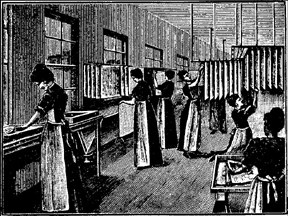Albumen was the most popular method of printmaking from abut 1860 until about 1900. The papers were hand made, most of them in France and Germany, by coating writing paper with a mixture of eggs whites and salt. Photographs show lines of European women floating the paper in trays of egg whtes and hanging them to dry.
Commercial manufacture of albumen paper ceased in the 1920s as Kodak, Ilford, Agfa and others made silver gelatin paper popular.
If you have photographs from the late 1800s, there’s a good chance these were albumen prints. Properly processed, these prints retain their wonderful color, sharpness and contrast. However, many of the photos from this period were made for speed and longevity, so many of them have faded.
I made albumen paper myself from 100% cotton Crane’s writing paper. I coat it in the same kind of mixture of egg whites and salt, and hang the indivitual sheets to dry. I heat the sheets to cure them.
When making your print, I take a previously prepared albumen sheet and coat it with silver nitrate. This coating is applied by hand with a brush, so that individual variations are achieved. The paper is then placed in a contact printing frame along with the negative, and exposed to untraviolet light.
The negatives are all 8×10 and are made with a view camera. The prints cannot be enlarged.
After exposure, the prints are washed, then toned with gold. The toning process also introduces individual variations to each print. Then the prints are processed using modern archival methods so that they will not fade as earlier prints sometimes did.
The variations in coating the silver and in processing mean that no two prints are exactly alike, although they are very similar. The color can vary from a dark brown to a more reddish brown in the shadows, and from a creme to a bluish-grey in the highlights. In looking at the scans on the Internet, the process of scanning and the setup of each person’s monitor also introduces variations, so the prints will vary a bit from what you see on your screen.


